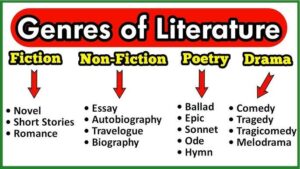Back to: LITERATURE IN ENGLISH SS1
Welcome to class!
We are thrilled to have you in our class!!
In today’s class, we will be talking about the genres of literature. Enjoy the class!
Genres of Literature I

The word “genre” is of French origin and it means “kind or sort”. It is the organisation of literature into categories based on the type of writing the piece exemplifies through its content, form, or style. In literature, there are three types of genre namely:
- Poetry
- Prose and
- Drama
Poetry
According to Samuel Taylor Coleridge and William Wordsworth in their seminal work titled the Lyrical Ballad (1798), poetry is the spontaneous overflow of powerful emotions recollected in tranquillity. Poetry is a major literary genre that can take many forms.
Some common characteristics that poetry shares are that it is written in lines that have meter and rhythm. These lines are put together to form stanza in contrast to other writings that utilize sentences that are divided into paragraphs. Poetry often relies heavily on figurative languages such as metaphors and similes to convey meanings and create images for the reader.
Types of poetry
- Sonnet: This is a one stanza fourteen-line poem written in iambic pentameter (i.e. a line of ten syllables, which alternate stressed and undressed syllables according to the iambic rhythm).An example is “Sonnet 18” which is a poem by William Shakespeare. It is a structured poem that consists of 14 lines that follow a meter (iambic pentameter) and a rhyme scheme that is consist of Shakespearean Sonnet. Its rhyme scheme is usually “ababcdcdefefgg”.
- Ode: This is a classical musical poem that is meant to be sung. It is also a lyrical poem, typically one in the form of an address to a particular subject, written in varied or irregular metre. An example is John Keats’ “Ode on a Grecian Urn”.
- Elergy/Dirge: This is a sad, mournful or melancholic poem that is recited for the dead at a funeral. An example is “Adonais” which was written in 1821 on the death of John Keats by Percy Bysshe Shelley.
- Epic: This is a lengthy narrative poem that is written on a serious subject to praise heroic deeds and events of the significance of a culture or nation. Examples of this include Homer’s “The Iliad” and “The Odyssey”.
- Ballad: This is a narrative poem that tells a story. Ballads began as folk songs and continue to be used today in modern music. A typical ballad consists of stanzas that contain a quatrain, or four poetic lines. The meter or rhythm of each line is usually iambic, which means it has one unstressed syllable followed by a stressed syllable. In ballads, there are usually eight or six syllables in a line. Like any poem, some ballads follow this form and some don’t, but almost all ballads are narrative, which means they tell a story. An example is Samuel Taylor Coleridge’s “The Rime of the Ancient Mariner”.
- Pastoral poem: This poem is seen to talk about Shepard, livestock, farmers or peasants and rural life. It also usually talks about a communal setting. An example of this is Christopher Marlowe’s “The Passionate Shepard to His Love”.
- Panegyric: This is a formal public speech or written verse delivered in high praise of a person or thing. An example of this is Oluwasola Abiola’s “I Am of OAU”.
- Nonsense poem: This is a poem that was made popular by Edward Lear. It is a poem via speech, writing or any other communication system that lacks coherent meaning. An example is Anonymous’ “Hey Diddle Diddle”
- Limerick: This type of poem is a humourous five-line poem with a rhyme scheme of aabba. It was also made popular by the popular English poet, Edward Lear. The first, second, and fifth lines must have seven to ten syllables while rhyming and having the same verbal rhythm. The third and fourth lines should only have five to seven syllables; they too must rhyme with each other and have the same rhythm. An example of a Limerick is Edward Lear’s “There Was An Old Person of Dean”.
- Lyric: This is a type of short poem which expresses deep personal feelings, thoughts and emotions. It is usually sung and accompanied by the music of the lyre. An example of a lyric is William Butler Yeats’ “He Wishes for the Cloths of Heaven”.
In summary, when we study the genres of literature, we get a deeper understanding of the diversity and richness of literary works.
Evaluation
What themes are explored in “The Lion and the Jewel” and “The Road Not Taken”?
Reading Assignment
What are the different genres of literature?
Weekend Assignment
Discuss the importance of genres in literature and how they help readers understand and appreciate literary works.
We hope you enjoyed today’s class. In our next class, we will be talking about Genres of Literature II.
Let us know your thoughts and questions in the comment section, and we will attend to them as fast as we can.

More about drpama
Thank you for your kind review.
More on drama
what a wonderful lesson